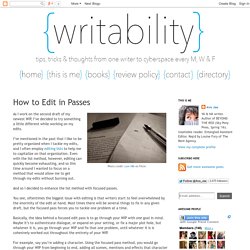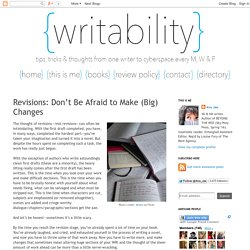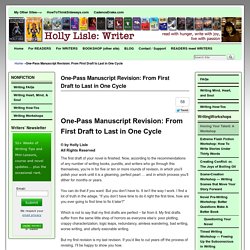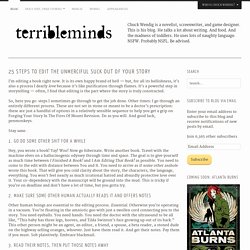

Follow the Leader: Moving From Scene to Scene. By Janice Hardy, @Janice_Hardy Sometimes I find an interesting trick without meaning to.

I was going through my novel, Darkfall, skimming chapters and trying to work out how to better weave all my various plot threads together. Since it's the third (and last) book of the trilogy, there are four major plot ideas that all have to be tied together and wrapped up, and I wasn't happy with how they wove together. Things felt too unfocused, even though I liked what was happening on a scene by scene basis. I found myself checking the ends of every scene and chapter and making notes on the plot and narrative flow, because scene and chapter enders are usually where most the plot-advancing stuff happens. Going through the enders made me see much more clearly where my plot was going, and when an ender left with one problem and picked up somewhere else, it was blindingly clear where my disconnects were.
Once I realized what the problem was, it wasn't hard to fix at all. TweetDeck. How to Edit in Passes. As I work on the second draft of my newest WIP, I’ve decided to try something a little different while working on my edits.

I’ve mentioned in the past that I like to be pretty organized when I tackle my edits, and I often employ editing lists to help me to capitalize on that organization. Even with the list method, however, editing can quickly become exhausting, and so this time around I wanted to focus on a method that would allow me to get through my edits without burning out. And so I decided to enhance the list method with focused passes. You see, oftentimes the biggest issue with editing is that writers start to feel overwhelmed by the enormity of the edit at hand. How to Rewrite Old WIPs Like a Pro. So I've written in the past about how to know when it's time to shelve your WIP, and I've talked about how trunking your work doesn't mean the death of your novel, but I never really covered the afterlife of a trunked work: that is, the un-trunking.

Ok, so un-trunking probably isn't a word, but hopefully you get what I mean. I truly believe that nothing you write ever goes to waste — at least, not for writers. We learn and gain experience from every piece we write — whether it's an essay for school, or a report for work, or a poem scratched on the back of a napkin, or an 80k novel shoved in the drawer. You see, the great thing about putting WIPs that weren't working at the time away, is that nothing is stopping you from going back at a later time to bring them back to life. Or, if more drastic measures are necessary, cannibalizing its parts to create a completely new version of the novel. Choose your soon-to-be reincarnated WIP wisely. Revisions: Don’t Be Afraid to Make (Big) Changes. The thought of revisions—real revisions—can often be intimidating.

With the first draft completed, you have, in many ways, completed the hardest part—you’ve taken your imagination and turned it into a novel. But despite the hours spent on completing such a task, the work has really just begun. With the exception of authors who write astoundingly clean first drafts (these are a minority), the heavy lifting really comes after the first draft has been written. This is the time when you look over your work and make difficult decisions. This is the time when you have to be brutally honest with yourself about what needs fixing, what can be salvaged and what must be stripped out. Writability: Editing Technique: Lists. Flogging the Quill: Eliminate filters that dilute the reader’s experience.
While most of my new book, Mastering the Craft of Compelling Storytelling, is updated material from the original and out-of-print Flogging the Quill, Crafting a Novel that Sells, there is new material as well.

I thought I’d share a new chapter with you on the topic of what are called “filters.” The filters you’ll read about on the Internet are a common problem—I call them action filters—but I think I’ve identified a second kind of filter that can diminish a narrative: body-part filters. See what you think. Top Three Revision Tips from Fiction University’s Janice Hardy. Views824Likes2Ratings12345 By Guest Contributor Janice Hardy.

One-Pass Manuscript Revision: From First Draft to Last in One Cycle. © by Holly Lisle All Rights Reserved The first draft of your novel is finished.

Now, according to the recommendations of any number of writing books, pundits, and writers who go through this themselves, you’re in for five or ten or more rounds of revision, in which you’ll polish your work until it is a gleaming, perfect pearl … and in which process you’ll dither for months or years. You can do that if you want. 25 Steps To Edit The Unmerciful Suck Out Of Your Story. I’m editing a book right now.

It is its own happy brand of hell — but, for all its hellishness, it’s also a process I dearly love because it’s like purification through flames. It’s a powerful step in storytelling — often, I find that editing is the part where the story is truly constructed. So, here you go: steps I sometimes go through to get the job done. Other times: I go through an entirely different process. These are not set in stone or meant to be a doctor’s prescription: these are just a handful of options in a relatively sensible sequence to help you get a grip on Forging Your Story In The Fires Of Mount Revision. Stay sane. 1. Hey, you wrote a book! 2. Other human beings are essential to the editing process. 3.
They gave you notes. 4. You need to re-read your book. 5.